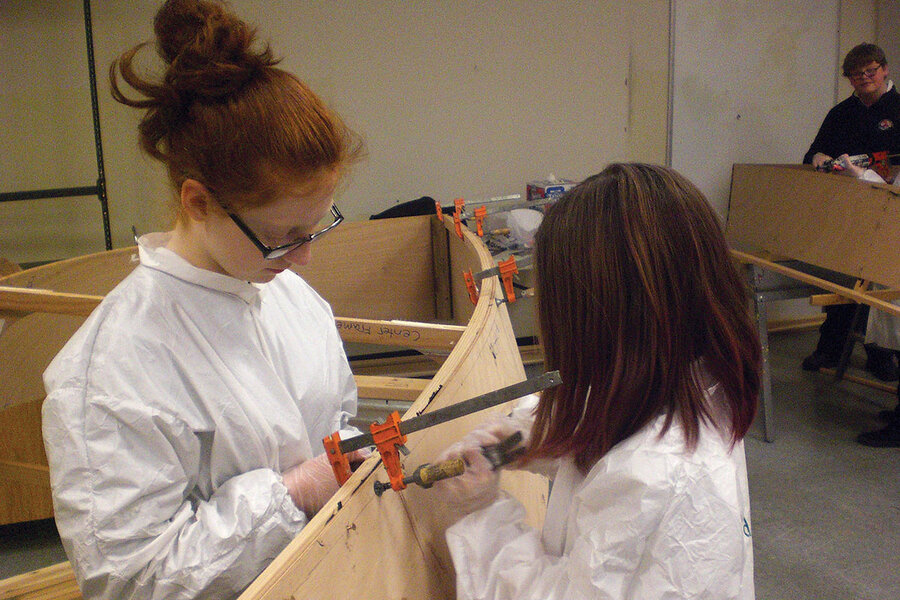In Philadelphia, students get a chance to build boats – and launch them
Loading...
An educator and sailor, Nicholas Pagon was struck by the scenario of middle-school students reading a novel about an ocean voyage in a sailboat.
That’s because even though the students were in Philadelphia – a city on the Eastern Seaboard that’s home to the famed Boathouse Row on the Schuylkill River – few had ever been in a small boat, and probably none had been out on the ocean.
Mr. Pagon was determined to find a way to introduce more forms of engaged and experiential learning into school curricula. So in 2014 he launched Philadelphia Waterborne, which offers middle- and high-schoolers the opportunity to participate in boat-building while exploring environmental issues, maritime history, and school subjects such as geometry and physics.
“I wanted them to use their hands, and I use every opportunity to reinforce the concepts they’re learning in the classrooms,” says Pagon, who is also a woodworker. “And I wanted them to build something real.”
Philadelphia Waterborne partners with schools, which supply a workspace for boat-building, a teacher to work with Pagon, and an academic focus for each class. The program also teams up with cultural arts groups that provide access to rivers, storage space, and opportunities for community engagement.
Pagon’s program typically takes place weekly from November through April, with students constructing boats that, while simple, are indeed seaworthy.
“I make sure at the end of the project that the students launch the boats onto the Schuylkill River,” he says in a phone interview. “For city kids, most of whom do not swim and have never been on a small boat and have been brought up to be afraid of the rivers, this is a really big deal.”
Pagon provides all the necessary tools and materials – including marine plywood, spruce, and oak. This season, he is building 10 boats at four schools with roughly 75 students. After the current classes are concluded, Pagon’s program will have produced 45 boats and engaged some 250 students.
The culmination of the program – the launch of boats during a field trip – is a thrill for the students, as well as parents who come out for the occasion.
“They are scared to do it, but they do it,” Pagon says of students launching the boats on an active river. “They are so proud and so excited at the end about what they’ve accomplished.”
Not just in the schools
All the boats then become part of a community boating program at Bartram’s Garden, a National Historic Landmark in the city that sees some 40,000 visitors a year – some of whom go for a ride in the boats.
“I wanted [the students] to build something that they saw their adult communities using – it wasn’t just in the schools,” Pagon says.
The program is part of CultureTrust Greater Philadelphia, a nonprofit that acts as its fiscal steward. Last year, the program’s budget was a mere $50,000, supported in large part by school partners and community organizations as well as corporations and individual donors.
“The schools are pleased and keep asking me to come back,” Pagon says, noting that he has had to start turning away new potential school partners until he is able to train others about the programming.
“The impact on the students’ sense of self-worth and accomplishment is palpable, and I believe that the programs create a valuable real-world context for why they are learning what they are learning in the classroom,” he adds.
The program made headlines this past winter when six rowboats were lent to the people reenacting George Washington’s crossing of the Delaware River, after low water levels posed problems for the boats traditionally used. Although the crossing ended up being canceled because of dangerous winds, Pagon hopes to forge a partnership with the reenactors in future years.
An 11-year-old’s perspective
Nicole Moyano, a fifth-grader attending Maritime Academy Charter School, was part of a sailing club through her school before she became interested in boat-building. She has been participating in Philadelphia Waterborne for a few months.
The 11-year-old describes Pagon as “hardworking and helpful” in an email interview, noting that he is quick to assist the students when they need it.
“Mr. Nick shows us lots of patience while he teaches us how to build the boat,” Nicole says. “You can also see how knowledgeable about boats he is. I know this because he always answers our questions and teaches us the history of boats and where we can find ports.”
She says she has learned how to use various tools, including clamps, hammers, a bucking iron, a drill, and a glue gun. She’s also relied on some mathematical concepts that lend themselves to boat-building, such as fractions.
Nicole describes her experience with Philadelphia Waterborne “as a breeze” so far. And she talks about the anticipation that’s growing for the end result.
“There is also a lot of excitement with almost being done with our boats,” she says. “I am excited for painting and getting to take them out in the water later this year.”
• For more, visit philadelphiawaterborne.org.





